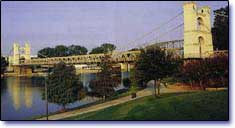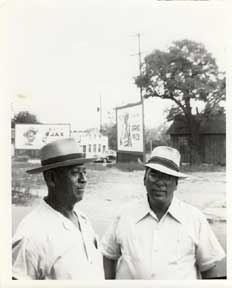

Places in Time
"Calle Dos" characterized
by cultural richness
By David Doerr, Tribune-Herald staff writer
Oct. 17, 2005
Photo right: Jesus Duron, left, owner of Jesus Duron Groceries, and Ramon Lopez Sr., owner of Lopez Grocery and Market, stand at the corner of Second and Jefferson in an undated photo.
Back when Raymond Navarro was young, police once caught him swimming nude in a fountain supplied by an artesian springs in a Waco neighborhood that no longer exists.
Navarro shared his memory of Calle Dos, a part of Waco long gone but hardly forgotten, at a forum sponsored by the Waco History Project at St. Francis Catholic Church. Former residents of the heavily Hispanic neighborhood filled the church's parish hall where they nodded knowingly as old friends told stories of how things once were.
“In seventh-grade history class they talked about Mexicans in not such a good way,” said Margie Cintron, moderator of Wednesday's forum, who said it has become her cause to help document the history of Calle Dos to improve how Texas history is taught in public schools.
Bounded between Fourth Street and the Brazos River and Washington Avenue and present day Waco Drive , Calle Dos has a special historical and cultural significance for its former residents and the city of Waco .
The origins of Calle Dos can be traced to the late 1800s, when city leaders legalized prostitution along a portion of Second Street known as “The Reservation,” said Rebecca Sharpless, director of Baylor's Institute for Oral History.
However, once the federal government proposed building Camp MacArthur outside Waco , city leaders decided to shut down the red-light district because federal officials frowned on army bases being located near places with legalized prostitution, she said.
When the Mexican Revolution began driving immigrants north into the United States, many found their way to the neighborhood filled with houses left empty from the eviction of prostitutes, Sharpless said.
“Nobody wanted to buy those houses in the red section, but (my father) didn't care,” said Tina Chavez, whose father owned Duron's Grocery Store on Second Street .
Several members of the Duron family recalled growing up in a house with 15 rooms and wondering why there were numbers on the doors. Chavez said she remembered asking her father about the numbers.
Displaced by development
“He said there were bad girls who lived here,” she recalled.
Many businesses owned by neighborhood residents eventually developed along Second Street , which became a vibrant thoroughfare, Cintron said. However, the neighborhood began to disappear in the 1960s, when federal urban renewal initiatives led to the demolition of many buildings in downtown Waco .
While some residents were displaced, many stayed in Waco , Cintron said.
Joseph Gonzales, who recalled building kites out of popsicle sticks, said the neighborhood's poverty made growing up tough. Even so, residents managed to make life enjoyable.
“Times were hard, but I didn't know anybody who wasn't going through a hard time,” he said, “so everything was normal.”
For
more information, contact: John Young • Waco
Tribune-Herald •